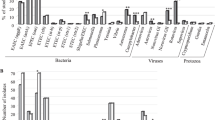Abstract
The aim of this study was to establish the incidence of fecal carriage of Listeria monocytogenes in healthy adults. A total of 868 stool specimens from three healthy volunteers (1 male and 2 females; ages 44, 39, and 60 years) were collected between 1 October 2000 and 30 September 2001. Culture was performed using Fraser broth and Palcam selective agar plates. Polymerase chain reaction (PCR) was performed using Probelia Listeria monocytogenes (BioRad, France). Overall, Listeria monocytogenes was detected in 31 of the 868 (3.57%) stool specimens using PCR. Sixteen of the 31 positive results were single events, i.e., samples collected from the same patient the day before and the day after the positive result were both negative. Positive results on two consecutive days were found four times, on three consecutive days one time, and on four consecutive days one time. Listeria monocytogenes was cultured from 10 of 868 (1.15%) stool specimens. These culture-positive samples, all positive by PCR as well, accounted for five independent episodes. Using automated ribotyping on up to 40 single colonies per stool specimen, 9 of 10 culture-positive samples yielded more than one strain. There was no obvious seasonal clustering of positive results. None of the documented episodes of Listeria monocytogenes carriage, all of which involved serotypes 1/2a and 1/2b, coincided with overt illness. The results of PCR indicate an incidence of five to nine exposures to Listeria monocytogenes per person per year. On average, the incidence of culture-confirmed fecal carriage in healthy adults is two episodes of Listeria monocytogenes carriage per person per year. Fecal shedding was of short duration (maximum 4 days), which argues against the appropriateness of routine stool screening in dairy workers as a tool for prevention of listeriosis.

Similar content being viewed by others
References
Allerberger F, Wagner M, Rieck P, Fussing V, Jacquet C (2001) Nationale Referenzzentrale für Listerien: Jahresbericht 2000. Mitt Sanitätsverwalt 102:12–15
Grif K, Hein I, Wagner M, Brandl E, Mpamuga O, McLauchlin J, Dierich MP, Allerberger F (2001) Prevalence and characterization ofListeria monocytogenes in faeces of healthy Austrians. Wien Klin Wochenschr 113:737–742
Cobb CA, Curtis GD, Bansi DS, Slade E, Mehal W, Mitchell RG, Chapman RW (1996) Increased prevalence ofListeria monocytogenes in the faeces of patients receiving long-term H2-antagonists. Eur J Gastroenterol Hepatol 8:1071–1074
Chin J (2000) Control of communicable diseases manual. American Public Health Association, Washington DC, p 297
Iida T, Kanzaki M, Nakama A, Kokubo Y, Maruyama T, Kaneuchi C (1998) Detection ofListeria monocytogenes in humans, animals and foods. J Vet Med Sci 60:1341–1343
MacGowan AP, Marshall RJ, Mackay LM, Reeves DS (1996)Listeria faecal carriage by renal transplant recipients, haemodialysis patients and patients in general practice: its relation to season, drug therapy, foreign travel, animal exposure and diet. Epidemiol Infect 106:157–166
MacGowan AP, Bowker K, McLauchlin J, Bennett PM, Reeves DS (1994) The occurrence ofListeria spp. in human faeces, shop-bought food stuffs, sewage and soil from urban sources. Int J Food Microbiol 21:325–334
Ralovich B (1984) Listeriosis research. Present situation and perspective. Akadémiai Kiadó, Budapest, p 64
Seeliger HPR, Finger H (1983) Listeriosis. In: Remington JS, Klein JO (eds) Infectious diseases of the fetus and newborn infant. Saunders, Philadelphia, pp 264–289
Schuchat A, Deaver K, Hayer PS, Graves L, Mascola L, Wenger JD (1993) Gastrointestinal carriage ofListeria monocytogenes in household contacts of patients with listeriosis. J Infect Dis 167:1261–1261
Centers for Disease Control and Prevention (1996) Preventing foodborne illness: listeriosis. Document no. 1996-0-735-177. U.S. Government Printing Office, Washington DC
McLauchlin J (1987) A review:Listeria monocytogenes recent advances in the taxonomy and epidemiology of listeriosis in humans. J Appl Bacteriol 63:1–12
Allerberger F, Fritschel SJ (1999) Use of automated ribotyping of AustrianListeria monocytogenes isolates to support epidemiological typing. J Microbiol Methods 35:237–244
Slutsker L, Schuchat A (1999) Listeriosis in humans. In: Rysaer ET, Marth EH (eds) Listeria, listeriosis and food safety. Marcel Dekker, New York, pp 75–95
Allerberger F, Gyimothy J, Mann M, Hof H, Dierich MP (2000) Infektionen mitListeria monocytogenes. In: Janata O, Reisinger E (eds) Infektiologie Aktuelle Aspekte Jahrbuch 2000. Österreichische Verlagsgesellschaft, Vienna, pp 169–177
Aureli P, Fiorucci GC, Caroli D, Marchiaro G, Novara O, Leone L, Salmaso S (2000) An outbreak of febrile gastroenteritis associated with corn contaminated withListeria monocytogenes. N Engl J Med 342:1236–1241
Dalton CB, Austin CC, Sobel J, Hayes PS, Bibb WF, Graves LM, Swaminathan B, Proctor ME, Griffin PM (1997) An outbreak of gastroenteritis and fever due toListeria monocytogenes in milk. N Engl J Med 336:100–105
Miettinen MK, Siitonen A, Heiskanen P, Haajanen H, Bjorkroth KJ, Korkeala HJ (1999) Molecular epidemiology of an outbreak of febrile gastroenteritis caused byListeria monocytogenes in cold-smoked rainbow trout. J Clin Microbiol 37:2358–2360
Swaminathan B (2001)Listeria monocytogenes. In: Doyle MP, Beuchat LR, Montville TJ (eds) Food microbiology: fundamentals and frontiers. American Society for Microbiology, Washington DC, pp 383–409
Acknowledgements
This work was supported by grants of the European Commission (GENE project QLK2-2000-01404) and the Austrian Jubilee Fund (no. 9292).
Author information
Authors and Affiliations
Corresponding author
Rights and permissions
About this article
Cite this article
Grif, K., Patscheider, G., Dierich, M.P. et al. Incidence of Fecal Carriage of Listeria monocytogenes in Three Healthy Volunteers: A One-Year Prospective Stool Survey. Eur J Clin Microbiol Infect Dis 22, 16–20 (2003). https://doi.org/10.1007/s10096-002-0835-9
Published:
Issue Date:
DOI: https://doi.org/10.1007/s10096-002-0835-9



